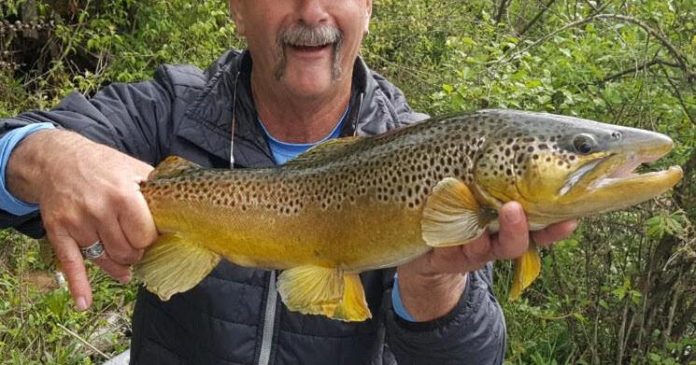I remember well my first time to fish for wild trout in a Colorado stream. I was about 30 years old, a couple buddies and I had made arrangements with a rancher to do a three day drop camp hunt for mule deer on his ranch near Silverton. When we arrived, the rancher had the camp all set up, complete with a supply of aspen wood for the wood stove. It gets chilly in the mountains in October! When making plans for our drop camp, he asked if we liked to fish and the answer was a resounding yes. He mentioned a little stream that traversed his property that was full of brook trout.
None of us were fly fishermen, but we all packed our light weight spinning gear with an assortment of small spinners and several jars of salmon eggs, light clamp on weights and small trout hooks. None of us put our tag on a buck mule deer on that hunt. We might have been more successful had we hunted throughout the day rather than heading back to camp after a short morning hunt and fishing the stream until the afternoon hunt. On this short hunt, I became “hooked” on catching and eating trout. Granted, the brookies were small trout but they put up a great fight on the ultra light gear we were using and they were a gourmet’s delight in tin foil, butter with a squeeze of lemon!
I later outfitted elk and bear hunts with my friend in the mountains north of Steamboat Springs, Colorado. The ranch we leased for hunting had an excellent trout stream within short distance of camp. Here we landed some big trout, both German browns and rainbows. Between groups of hunters, we spent time fishing the private waters on the ranch and catching was very good. I still remember some of the awesome meals of wild rice and grilled trout!
A highlight of fishing for trout is enjoying the awesome scenery along trout streams. It seems trout and beautiful country go hand in hand. In just a couple weeks, I was fishing up in far northern Saskatchewan for giant lake trout and northern pike. While fishing up north, I began thinking about trout waters close to home that didn’t require the long drive to the Rockies.
Oklahoma and Arkansas has some great trout streams. The White River in Arkansas below Bull Shoals is a world class trout fishery and in Oklahoma, we have Mountain Fork River below Broken Bow Lake. A stretch of this river runs through Beavers Bend Park and provided easy access for many Texas fishermen.
The Little Red River below Greers Ferry Reservoir in Arkansas near Heber Springs might not be as well known as the White River, but provides excellent trout fishing on the 29 miles of superb trout habitat below the dam at Greers Ferry. This stretch of river is well known for producing jumbo brown trout and lots of action on hard fighting rainbows. Lodging and guide services is available at many resorts along the river.
The lower Illinois River below Ten Killer dam about six miles northeast of Gore, Oklahoma in Sequoyah County provides some great trout fishing as well. Blue River, located about eight miles north of Tishomingo is a great spot that is usually well stocked with rainbows.
To get started on your quest for trout waters, the fish and game departments for Arkansas (www.agfc.com) and Oklahoma (www.wildlifedept.com) are great sources. It’s also a good idea to Google trout guides in areas you wish to fish and give them a call and explore the possibility of booking a trip. I highly recommend hiring a guide on waters that are new to you, at least for that initial trip. You’ll learn a great deal and then, should you wish to fish on your own later, you will have a good idea of where and how to be successful.
A guided trout trip on the White River is a great introduction to trout fishing. The White is well stocked with trout and you have the very real opportunity to catch a big one. A great spot to headquarter here is Copper Johns Resort( www.copperjohnsresort.com), located on the banks of the river below the Bull Shoals dam. Mike Dexter (501-515-1119) guides on the White and is an excellent source of information.
Tackle for trout
Trout fishermen traditionally use either fly rods or spinning gear. Tricking a trout with a fly designed to imitate an insect the trout are feeding upon might just be the ultimate fishing challenge, and the reason so many trout anglers are fly fishermen. Many trout are landed on ultra-light tackle spinning tackle with four to six pound line, and very small hooks, size eight to 14.
Live or prepared bait always works best but it’s not allowed in all trout waters so it’s important to check local regulations. Flies and small spinners or jigs also will catch fish (artificial lures and barbless hooks are required in some areas. Fish near large rocks and logs and in eddy water adjacent deeper holes … bends in the stream often hold trout. Cast upstream and, keeping a tight line, allow the current to move baits along. I’ve always marveled at how a trout can hone in on a tiny dry fly, salmon egg or small spinner in fast moving waters.
Trout are ambush feeders, like largemouth bass and often stage in slack water on the down current size of large rocks, when the bait floats by the strike occurs quickly as the fish attempts to grab dinner before the current pushed it downstream.
Contact outdoors writer Luke Clayton by email. His website is www.catfishradio.org
Credit: Source link































